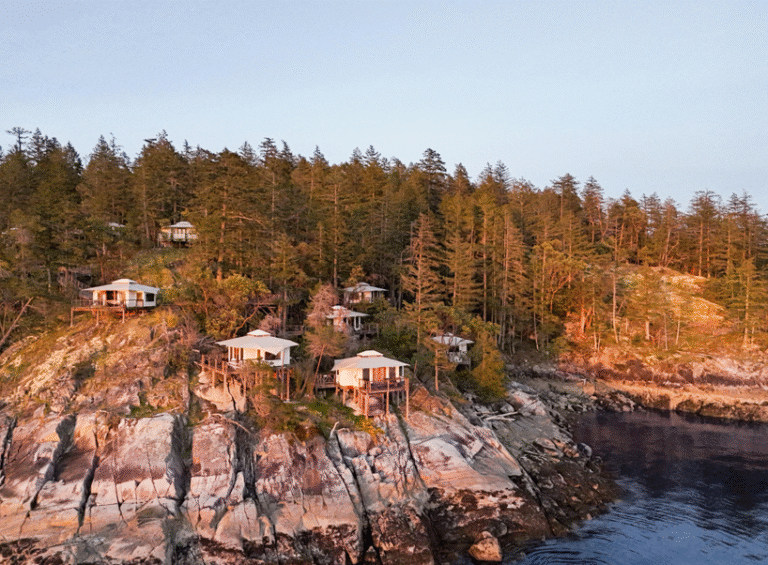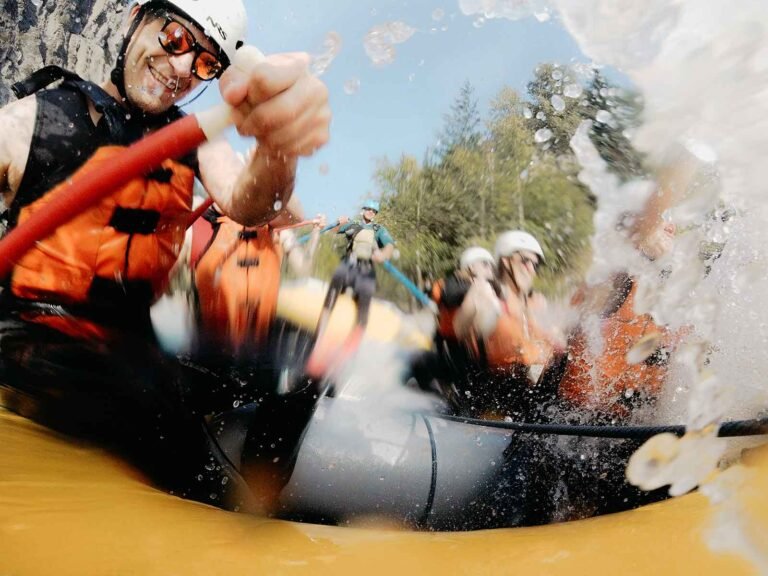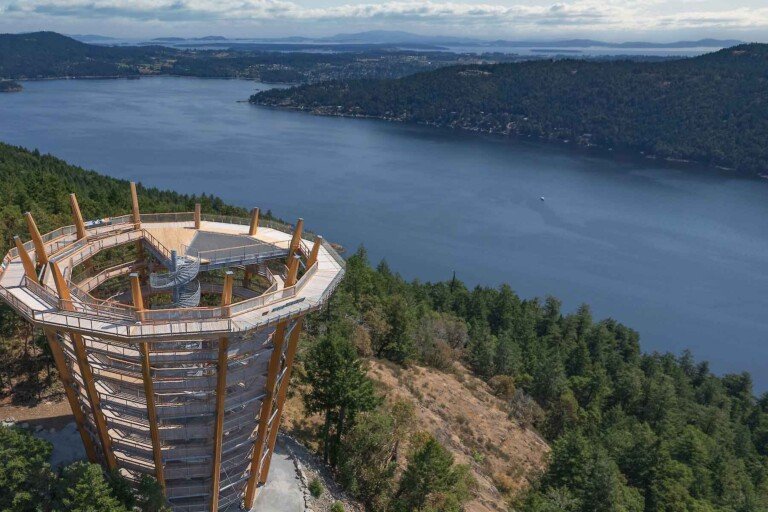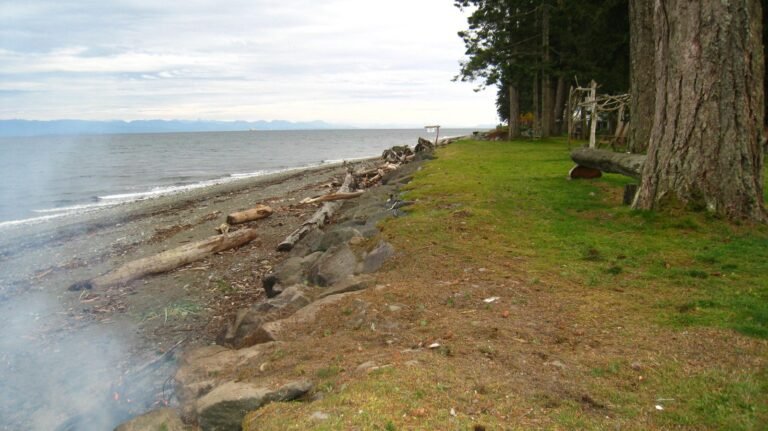Fraser Plateau
This region is littered with trails, both historical and modern. Unfortunately, many lie well off the beaten track along a maze of logging roads. Forest Service recreation maps of these areas are helpful and are available at the Prince George and Prince Rupert Forest District Offices, respectively.
The defining backpacking trek in this region, and perhaps in the entire province, is the Nuxalk-Carrier Grease Route/Alexander Mackenzie Heritage Trail. Alexander Mackenzie is Canada’s Lewis and Clark, both wrapped up into one intrepid explorer. Mackenzie was the first European to cross the Rocky Mountains, predating the aforementioned Lewis and Clark by 12 years. He travelled by canoe across much of Canada, but near Prince George, he set out on foot along pre-existing trading trails, established by Native British Columbians. The trails were used by First Nations primarily for trading eulachon grease, perhaps the most valued commodity in the northwest.
It is not necessary to hike the 264-mile (420-km) route from Prince George to Bella Coola in one trek in order to get a feeling for what Mackenzie encountered. There are a number of access points to the trail, mostly in the first 60 miles (100 km) or so. The main trailhead begins next to a parking lot on Blackwater Rd, southwest of Prince George, near a viewpoint that overlooks the Blackwater River Valley. To reach it, travel about 37 miles (60 km) south of Hwy 16 on Blackwater Road, which begins west of Prince George. You can also fly in via floatplane to points along the trail – or, rather, trails, as this is not so much a single trail wending over hill and dale as it is a network of interconnected trails, fragmenting into a dizzying array of routes in some places.
Sometimes, these are just different routes around a lake, while at other points the trails lead to different destinations entirely. Proper maps and a compass are indispensable. The main trail stretches from the primary trailhead, just south of Prince George where Blackwater Forest Service Road ends at the confluence of the Blackwater and Fraser Rivers, through Tweedsmuir Provincial Park and all the way to Bella Coola, though not to the actual site Alexander Mackenzie reached. To get there, you’ll need to take a boat from Bella Coola to Mackenzie Rock to see the famous inscription: ‘Alexander Mackenzie, from Canada, by land, 22nd July 1793.’
If you do attempt to hike the entire trail in one fell swoop, bear in mind that experienced hikers can expect to take three weeks, and most of the trail runs through remote wilderness areas, far from civilization. The trail is best done in late summer or early fall. Any earlier, and the black flies and mosquitoes in some of the lower, wetter areas can be unbearable. No matter how much or little of the trail you want to hike, you must plan ahead. An excellent guide to the entire trail is In the Steps of Alexander Mackenzie published by the Alexander Mackenzie Trail Association, Box 425, Kelowna BC, V1Y 7P1.
The Alexander Mackenzie Heritage Trail runs through Tweedsmuir South Provincial Park, but it’s not the only trail of length in this park. Tweedsmuir is serious backcountry camping, and the only road access is to the southern half of the park via Hwy 20 from Hwy 97 near Williams Lake. To reach the northern half of the park, you’re limited to floatplane from the town of Burns Lake, jet-boat from Ootsa Landing, or by foot or horseback via the Alexander Mackenzie Heritage Trail.
Most of the northern half of Tweedsmuir is encircled by the lakes that comprise the Nechako Reservoir: Ootsa Lake and Whitesail Lake define the north and west boundaries of the park respectively, while Eutsuk Lake bisects the park, turning northern Tweedsmuir into a huge, unpopulated near-island (Eutsuk and Whitesail fall about a half-mile/1 km short of connecting). A series of trails start from Wistaria Provincial Park, located on the north shore of Ootsa Lake about 80 km southwest of Burns Lake via Hwy 35, the Ootsa-Nadina Junction Rd, and the Wistaria Hwy. To hike this route, you’ll need to get across nearly 3 miles (5 km) of open water on Ootsa Lake, which is notorious for sudden changes of weather and high winds. For this reason, canoeing across the lake is not recommended. Once across, though, hiking trails lead to Sabina Lake, Chief Louis Lake, Nutli Lake, and ultimately Blanchet Lake, 30 miles (50 km) beyond Ootsa Lake. Hikers can arrange to be dropped off and picked up by a local outfitter or tour operator, in Vanderhoof. There is little margin for error in this wilderness area, and backpacking here is recommended for expert backcountry aficionados only.
The Babine Mountains Provincial Park, located about 9 miles (15 km) east of Smithers off Hwy 16 on gravel road, has an extensive interlinking trail system that leads into the open alpine regions. There are a lot of day-hike trails that can be knit together into two- or three-day loops through the park. This is an undeveloped wilderness area full of impressive mountains, glaciers, and broad alpine expanses. In winter, it’s a very popular backcountry ski destination. A good backcountry guide to consult is locally produced Trails to Timberline in Western Canada by Einar Blix. Populations are small in the northwest, and almost everyone knows everyone else.
The trailhead of the Mount Pope Hiking Trail (moderate; 7.5 miles/12 km return) is 3 miles (5 km) northwest of Fort St. James on Stones Bay Road. Allow a half-day for the hike to an old forestry lookout at top of 4,857-foot (1472-m) Mount Pope, from where you’ll enjoy sweeping views of big Stuart Lake and the Interior Plateau. For more information and a map of hiking trails in the area, stop by the Fort St. James Visitor Centre in town.
During the Klondike gold rush in the late 1890s, a telegraph line was constructed to connect the gold fields to the rest of civilization, which in those days began in central British Columbia around Prince George. The telegraph fell out of use in the 1930s with the advent of radio technology. Some parts of the old trail still survive; the longest of these connects Telegraph Creek to Atlin. A section of the Telegraph Trail west of Prince George off Hwy 16 runs from Hogsback Lake for about 6 miles (10 km), until it is lost under Blackwater Road. To reach the trailhead, drive 10.5 miles (17 km) south of Hwy 16 on the Bobtail Forest Rd, then 5 miles (8 km) west on Blackwater Road to Hogsback Lake.
The turnoff to Telegraph Road is near Fort Fraser, west of Vanderhoof on Hwy 16. Telegraph Road runs southeast, and connects with the Kluskus Forest Service Rd, which heads due south through the Nulki Hills for about 37 miles (60 km). There are a number of hiking trails along the way, including the Home Lake Trail, a 4-mile (6-km) trail to Home Lake. You can hike to the lake and back in a day but, as the Forest Service has been kind enough to build a cabin at the lake for you to use, why not stay the night? The trailhead is located at km 42.5 (about 26 miles) on the Kluskus Forest Service Road. About 6 miles (10 km) beyond is the Johnson Lake Trail. There’s no cabin here, but it’s a pretty spot to pitch a tent and enjoy swatting mosquitoes as the sun sets. The trail is about 3 miles (5 km) one way. A short distance beyond that on the Kluskus Forest Service Rd is the Gluten Lake Trail, which leads 3.5 miles (6 km) east to Gluten Lake, past Zippermouth Lake.
Also in the Vanderhoof region you’ll find a short interpretive trail in Beaumont Provincial Park. Across Hwy 16 from the park is the Fraser Mountain Trail. It’s about a 5-mile (8-km) return trip, from the bottom of an old ski hill to the top. This hike begins 25 miles (40 km) west of Vanderhoof. There’s good hiking on the north side of Fraser Lake at the Peterson’s Beach Forest Service Recreation Site. A perimeter road around Fraser Lake begins off Hwy 16 at the community of Stella. Follow this for about 12 miles (20 km) to reach the recreation site. On the other side of the road from Peterson’s is the Ormond Creek Trail, a 16-mile (26-km) return trip to Ormond Lake through Ormond Creek Canyon. The first half-mile or so of the trail passes through a 300-year-old Douglas fir forest.
The Morice Mountain Ski Trails in the Silverthorne Lake area of the Houston Community Forest are open to hikers in the summer. There is about 24 miles (40 km) of trails; the longest runs 5.5 miles (9 km) to Morice Mountain.
The northern part of Tweedsmuir North Provincial Park is best travelled by jet-boat. There are boat launches on Ootsa Lake at Andrews Bay Provincial Park and Wistaria Provincial Park. It takes about two days to do the circuit route created by Ootsa, Whitesail, Eutsuk, and Tetachuck Lakes by jet-boat; a few more if you take the time to hike some of the Tweedsmuir trails. Trails start across from Wistaria Provincial Park and lead back into the heart of Tweedsmuir. Shorter trails are scattered about, mostly at the western end of the two western lakes. The Chickamin Mountain Trail (3 miles/5 km return), Surel Lake Trail (1.5 miles/3 km return), and Musclow Lake Trail (1.5 miles/3 km return) are off Eutsuk Lake, while the Zinc Mountain Mining Road leads up the north side of the Chikamin Range from Whitesail Lake.
Bring your camera along when hiking the Fort George Canyon Trail, an almost 3-mile (4.5-km) ramble through flowers and shrubs to the banks of the Fraser River. To reach the trail, head for West Lake Provincial Park, west of Prince George, and continue for about 6 miles (10 km) along West Lake Road. The trailhead is well marked.
Bulkley Valley and Skeena River Valley
Wildlife viewing is a major attraction in the Kitlope Heritage Conservancy (Huchsduwachsdu Nuyem Jees). Grizzly and black bears, moose, mountain goats, caribou, and a wide range of birds are found throughout the Kitlope. A trip to the Kitlope often begins from the river estuary at Douglas Channel, which is reached by boat or air, and then you can backpack through the forest to the alpine regions above. Summers here are often as wet as winters, so don’t let weather influence your plans. One of the rewards of approaching by water is stopping at the Wewanie and Shearwater natural hot springs in Douglas Channel. Shearwater’s are considered by some to be the best hot springs on the north coast. During summer months, the area is monitored by a group of Watchmen (similar to park wardens) based in the Kitlope. Kitlope is jointly managed by BC Parks and the Haisla Nation.
Four hikes near Prince Rupert – the Butze Rapids, Oldfield Meadows, Tall Trees, and Mount Oldfield Trails – all begin almost 4 miles (6 km) east of the city centre, on Hwy 16. The Butze Rapids Trail (easy; 6 miles/10 km return) has a few steep sections as it loops through old-growth forest, bogs, and wetlands to the tidal flats of Grassy Bay, where a reversing tidal rapid puts on a whitewater performance twice a day (check the tide book). Depending on who you consult, a rising tide or a falling tide is best for viewing the rapids, which are reminiscent of Skookumchuk Narrows on the Sunshine Coast.
The Oldfield Meadows Trail (easy; 6 miles/10 km return) follows a cedar boardwalk through open meadows in a stunted bonsai forest. The granite that underlies much of the boggy terrain provides poor drainage, which accounts for the stunted growth in many of the low-lying coastal forests. The Tall Trees Trail (moderate; 4 miles/6 km return) begins by ascending a steep, almost 1,000-foot (300-m) boardwalk, then loops through a towering forest of Sitka spruce, western hemlock, balsam fir, and western red cedar. The trail crosses several creeks and finally leads to a view of Kaien Island.
For those in search of a longer hike, the Mount Oldfield Trail (strenuous; 12 miles/20 km return) takes you to the summit with its 1,837-foot (560-m) elevation. You can get to this trail from the Tall Trees Trail or Oldfield Meadows Trails. The summit of Mount Hays can also be reached via the Tall Trees Trail. Maps for these well-marked trails are available from the Prince Rupert Visitor Centre, and at the trailhead on Hwy 16.
The Bornite Mountain Trail (easy; 2.5 miles/4 km return) begins in Kleanza Creek Provincial Park, just east of Terrace, and follows an old mining road to the site of an abandoned placer gold operation. Along the way, hikers get a view down into the Kleanza Creek Canyon.
The Ferry Island Trail (easy; 4 miles/6 km return), beside Hwy 16 near Terrace, provides travellers with a relaxing stroll that circles through the woods and along the shoreline of the Skeena River. The beauty of the landscape – the broad, brown river surmounted by snowcapped Coast Mountain peaks – is extraordinary and well worth a stop to enjoy.
In summer, the trails in the Shames Mountain Ski Area, 22 miles (35 km) west of Terrace, lead hikers through meadows in full bloom and provides incredible mountainscape views. The well-marked ski trails serve as hiking trails, which vary from easy strolls to steep climbs. Maps are available at the day lodge and local sports shops.
The Kitimat area offers hiking as well. If you want a challenge, hike to the summit of Mount Elizabeth. Also recommended are the Bish Creek Trail and the Hirsch Creek Falls and Canyon Trail. Ask at the Kitimat Visitor Centre for detailed information.
Just west of Smithers is some of the best hiking of all. Glacier Gulch and Twin Falls are must-see destinations. Look for the signs on Hwy 16, 2.5 miles (4 km) west of Smithers, that indicate the turnoff west to the falls and gulch. The road is unpaved and may still have snow on its upper reaches through May. A short, rocky path leads to a lookout platform close to the parking lot. From there a short trail leads to the base of the south falls. The trail to view Lake Kathryn Glacier is a challenging, three-hour climb. The glacier, left over from the last ice age, lies in a mile-wide (2-km) gorge. Waterfalls plunge 525 feet (150 m) down the sides of the gradually melting glacier and feed alpine streams, some of which you must ford to get here.
Also near Smithers, Ski Hill Road to Hudson Bay Mountain provides elevated views of the Bulkley Mountains; in summer, this road climbs to tree line, then hiking trails lead into alpine meadows.
At Nisga’a Memorial Lava Bed Provincial Park, about 60 miles (100 km) north of Terrace, adjacent to New Aiyansh on the Nass Valley Rd, arrangements can be made for a guided 2-mile (3-km) hike to a volcano’s cone. Two centuries ago the volcano erupted, killing approximately 2,000 people. The pocked lava plain, 6 miles (10 km) long and 2 miles (3 km) wide, is an eerily moonlike landscape. If you want to circle around the park in your vehicle, take the Nass Forest Service Rd to join Hwy 37, and then meet Hwy 16 at Kitwanga. Watch out for logging trucks.
Stewart-Cassiar Hwy 37
Many of the trails in the Stewart area (along Hwy 37A) follow old mining routes, like the Sluice Box/Barney’s Gulch Trail, a short, moderately difficult trail that follows an old railway bed and a historic sluice box to a viewpoint overlooking Stewart. This trail starts on the southeast corner of town.
Another is the United Empire Loyalist Trail, also short and moderately difficult, which leads from the townsite of Stewart to a viewpoint overlooking Stewart and Bear Valley. Beyond the viewpoint, a more difficult, unkempt route continues on to the United Empire Loyalist Mine site. The Forest Service is currently working with local trail builders to connect the United Empire Loyalist Trail to the Titan Trail, a moderate to difficult hike to Titan Mine, located (barely) on the Alaska side of the British Columbia-Alaska border. When the route is finished, it will be an international trail (22 miles/36 km return). At present, the trailhead for Titan Trail is located 6 miles (10 km) north of Hyder, Alaska, on the Salmon River Road.
The Ore Mountain Trail starts from the Clements Lake Forest Service Recreation Site on Hwy 37A, about 6 miles (10 km) north of Stewart, and climbs steeply up Ore Mountain to alpine viewpoints overlooking the Bear Valley. The trail is only 6 miles (10 km) return, but with difficult sections where a great deal of elevation is gained. Spend a day hiking to Bear Glacier, 15 miles (24 km) west of Meziadin Lake Provincial Park on Hwy 37A. The name says it all. Follow the trail from Strohn Lake, and watch out for bears – black and grizzly – they’re everywhere.
There are two moderately short hiking trails in the Stikine River Provincial Park on Hwy 37. The first leads from a pullout near the northern park border to a viewpoint overlooking the Tuya River Valley. About 6 miles (10 km) beyond, a trail leads to the floor of the valley and on to the confluence of the Tuya and Stikine Rivers.
The most common modes of transportation into Mount Edziza Provincial Park are by horseback and floatplane, but you can also hike in. Mowdade Lake Trail leads 15 miles (24 km) from the trailhead at Kinaskan Lake Provincial Park to Mount Edziza Provincial Park, but you’ll need a boat to get across the Iskut River at the trailhead. The Klastline River Trail begins at the A-E Guest Ranch farther north at Iskut and follows the Klastline River to Buckley Lake. From here, the trail hooks up with the Buckley Lake Trail, which leads out of the park to (or into the park from) Telegraph Creek, or rather, the south banks of the Stikine River, across from Telegraph Creek. A trail runs from Mowdade Lake west to Coffee Crater, and then north, where it hooks up with the Buckley Lake Trail, though trail is perhaps too strong a word. Route would be more accurate, as these are unmarked, uncleared, undeveloped … well, routes. From Mowdade Lake to Buckley Lake is approximately 37 miles (60 km). Expect to take six to seven days to backpack in. Weather is unpredictable. Temperatures can hit 86 Deg F (30 Deg C) in the day, and drop below freezing in the evening, causing snowstorms. Only experienced backcountry travellers should attempt these routes without an experienced guide.
Telegraph Creek gets its name from an overland telegraph line to Yukon, the assembly of which was started in 1866. The project was stopped when the first trans-Atlantic submarine cable was laid, then started again during the Klondike gold rush. The cable was finished in 1901, and abandoned in 1936, when wireless radio killed it. Though the Yukon Telegraph Trail is mostly grown over to the south of Telegraph Creek, a 161-mile (265-km) stretch still survives between Telegraph Creek and Atlin, and is open to the serious backpacker.
‘Spatsizi’ means ‘red goat’ in the tongue of the original inhabitants of the area around Spatsizi Plateau, the Tahltan. The goats aren’t really red, but roll in iron-oxide dust, coating their otherwise white coats. The Spatsizi Plateau Wilderness Provincial Park is the second-largest park in the province, weighing in at 1,693,890 acres (656785 ha).To get there, turn east off of Hwy 37 onto the Ealue Lake Rd at Tatogga Lake. Follow the road for 13.5 miles (22 km), crossing the Klappan River, where it then intersects the BC Rail grade. The grade parallels the southwestern boundary of the park for 68 miles (112 km) and is rough but driveable for most vehicles. From here the park must be accessed by foot, horseback, or canoe. The two trails that lead into the park, the McEwan Creek Trail and the Eaglesnest Creek Trail, follow well-marked routes and connect to a number of other trails, some easier to follow than others. There are well over 100 miles (160 km) of trail in the park. An old outfitters’ cabin is available for public use at Cold Fish Lake. Many local guides are based in Iskut, strategically (and breathtakingly) placed between Mount Edziza and Spatsizi. The best source of information here is the Iskut Band Administration Office.
Tatlatui Provincial Park rubs noses with Spatsizi’s southeast corner. This is the only contact that Tatlatui has with anything. The closest road is well over 50 miles (80 km) away, leaving you to reach the park by air, horseback, or foot. If you’re planning on hiking this region, it is strongly recommended that you have a guide, as trails are not marked. Information on outfitters can be obtained from BC Parks in Smithers. The same goes for backpacking in Atlin Provincial Park and Recreation Area, as there are no marked routes in this park either.
Near Atlin, the Monarch Mountain Trail is a 6-mile (10-km) return climb of Monarch Mountain, with views of Atlin Lake. The trailhead is located at the Palmer Lake Forest Service Recreation Site, just south of Atlin.
Marking the extreme northwest corner of the province is the Tatshenshini-Alsek Provincial Park, which is nestled between Kluane National Park in Yukon and Glacier Bay and Wrangell – St. Elias National Parks in Alaska. The park – the largest in British Columbia – covers 2,366,260 acres (958,000 hectares) of rugged north-coast wilderness and, together with the other three adjacent national parks, comprise the largest contingent area of protected wilderness in the world, at around 21 million acres (8.5 million ha). The Tat, as it is known to people who have difficulty pronouncing the full name, is also designated by the United Nations as a World Heritage Site.
The blood that flows through the Tat’s veins is the icy cold water of hundreds of streams that feed that Tatshenshini River and Alsek River. There are two established entries into the park along the Haines Hwy (Hwys 3 and 7) from Yukon or Alaska and these provide access for hikers, backpackers, and mountain bikers. There are a very few trails in the park; for the most part, you have to make it up as you go along. Fortunately, game trails are plentiful.






